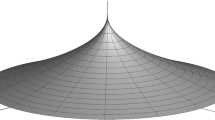Abstract
Given a complex polynomial p(z) of degree n, we are interested in characterization and computation of local optima — maxima or minima — of |p| over a disc D of radius r centered at the origin, or its boundary, ∂D. From the maximum modulus principle (MMP), together with parametrization of ∂D, maximization reduces to a univariate optimization. However, reduction to univariate optimization does not guarantee efficiency in the computation of local optima, nor gives any specific characterization, nor provides a bound on the number of local optima. In this article, we utilize the geometric modulus principle, a stronger result than MMP, to prove novel characterizations of local optima over D or ∂D. On the one hand, we prove any local optimum that lies on ∂D is necessarily a fixed point of \(F_{r}(z)=\pm r(p/p^{\prime })/|p/p^{\prime }|\) and also give a sufficiency condition. On the other hand, we show any fixed point is necessarily a root of a derived polynomialPr(z) of degree 2n defined in terms of p, \(p^{\prime }\) and their conjugate reciprocals. This also proves the number of local optima is at most 2n, an upper bound that can be attained. Our results imply that all desired local optima can be approximated to arbitrary precision in polynomial time. In particular, the classic \(\| p \|_{\infty }\) can be computed efficiently. Implementation of our algorithm using Matlab and MPSolve is capable of computing all roots of Pr(z) of degree up to 250 and subsequently all local optima of |p| to precision of 10− 13 in less than 3 s. In summary, the proposed theoretical algorithm is also practical and efficient. Additionally, based on the derived formulas we propose specialized algorithms and present sample visualization through polynomiography.




Similar content being viewed by others
References
Bak, J., Newman, D.J.: Complex Analysis, 2nd edn. Springer, New York (1997)
Beardon, A.F.: Iteration of Rational functions: Complex Analytic Dynamical Systems. Springer, New York (1991)
Bini, D.A.: Numerical computation of polynomial zeros by means of Aberth’s method. Numer. Algorithms 13, 179–200 (1996)
Bini, D.A., Robol, L.: Solving secular and polynomial equations: A multiprecision algorithm. J. Comput. Appl. Math. 272, 276–292 (2014)
Borwein, P., Erdélyi, T.: Polynomials and Polynomial Inequalities, vol. 161. Springer, New York (1995)
Boyd, J.P.: Computing the zeros, maxima and inflection points of Chebyshev, Legendre and Fourier series: Solving transcendental equations by spectral interpolation and polynomial rootfinding. J. Eng. Math. 56, 203–219 (2006)
Green, J.J.: Calulating the maximum modulus of a polynomial using Stečkin’s Lemma. SIAM J. Numer. Anal. 36, 1022 (1999)
Kalantari, B.: A geometric modulus principle for polynomials. Am. Math. Monthly 118, 931–935 (2011)
Kalantari, B.: Polynomial Root-Finding and Polynomiography. World Scientific, Hackensack (2008)
Kalantari, B.: Necessary and sfficient condition for local maxima of polynomial modulus over unit disc. arXiv:1605.00621v1 (2016)
Pan, V.Y.: Solving a polynomial equation: some history and recent progress. SIAM Rev. 39, 187–220 (1997)
Qazi, M.A.: On the maximum modulus of polynomials. Proc. Am. Math. Soc. 115, 337–343 (1992)
Acknowledgements
We would like to thank two anonymous referees for their constructive comments. In particular, we are grateful to a referee who observed an error in Example 1 which resulted in a correction in Theorem 2. The present article is an enhanced revision of [10]. We are also grateful to the Editor-in-Chief, Professor Claude Brezinski for his considerations.
Author information
Authors and Affiliations
Corresponding author
Additional information
Publisher’s note
Springer Nature remains neutral with regard to jurisdictional claims in published maps and institutional affiliations.
Rights and permissions
About this article
Cite this article
Kalantari, B., Andreev, F. & Lau, C. Characterization of local optima of polynomial modulus over a disc. Numer Algor 90, 773–787 (2022). https://doi.org/10.1007/s11075-021-01208-4
Received:
Accepted:
Published:
Issue Date:
DOI: https://doi.org/10.1007/s11075-021-01208-4



